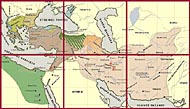The sudden death of Alexander the Great, in 323 BC in Babylon, caused great turmoil among the circles of his friends and generals, because they were called to decide the way in which the vast empire was to be governed in the future.
Only one legal heir of Alexander was to undertake the power since this seemed to be the most appropriate way to preserve the unity of the state. During this period, Alexander's half-brother, Philip Arrhidaeus, -the mentally impaired son of Philip II and a Thessalian dancer- and Alexander's unborn son from his Bactrian wife, Roxane, were such heirs.
|
The first 20 years after Alexander's death (323-310 BC) were marked by the incessant conflicts of his generals and friends almost in every region of the state. In the controversies among them, Antipater, Cassander, Lysimachus, Polyperchon, Eumenes, Perdiccas, Antigonus Monophthalmos ('the One-eyed') and his son Demetrius I 'Poliorcetes' ('Besieger of Cities'), Ptolemy I Soter ('Saviour') and Seleucus I Nicator ('Conqueror') played the leading roles. Without being interested in further expansion of the borders of the state, the friends and generals -sometimes contracting alliances among themselves and sometimes reversing these alliances and fighting against their former allies- initially pursued succession, and later the division of the kingdom. The battle at Ipsus in 301 BC, and the death of Antigonus terminated the first phase of the conflicts. From the new political situation 5 important kingdoms arose: that of Cassander in Macedonia, of Lysimachus in Thrace, of Seleucus I in Asia (from Mesopotamia to India), of Ptolemy in Egypt and Cyrene, of Antigonus and his son Demetrius I 'Poliorcetes' in Asia Minor and Cyprus. These latter two were recognized as kings by most of the cities of central Greece and by the koinon of the Islands.
| introduction |
Alexander |
successors |
kingdoms |
Greece |
freedom |
Note: Click on the small photo to enlarge it.
|

01. The most important kingdoms of Alexander's successors, as they resulted in 303 BC. That of Cassander in Macedonia, of Lysimachus in Thrace, of Seleucus I in Asia, of Ptolemy in Egypt and Cyrene, of Antigonus in Asia Minor and Cyprus.  |
